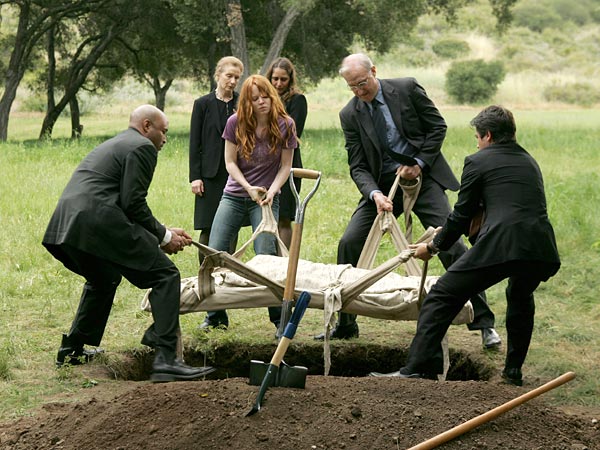
Six Feet Under is an American television drama series created and produced by Alan Ball. It premiered on the premium cable network HBO in the United States on June 3, 2001 and ended on August 21, 2005, spanning five seasons and 63 episodes. The show was produced by Actual Size Films and The Greenblatt/Janollari Studio and was shot on location in Los Angeles and in Hollywood studios. The show revolves around members of the Fisher family, who run their funeral home in Los Angeles, and their friends and lovers. The series traces these characters' lives over the course of five years. The ensemble drama stars Peter Krause, Michael C. Hall, Frances Conroy, Lauren Ambrose, Freddy Rodriguez, Mathew St. Patrick and Rachel Griffiths as the show's seven central characters.
Six Feet Under received widespread critical acclaim, particularly for its writing and acting, and consistently drew high ratings for the HBO network. Six Feet Under has frequently been described by critics as one of the greatest television series of all time.[1][2][3][4][5][6][7][8][9][10][11][12][13] The series is noted for its exploration of mortality and death in western society. It won numerous awards, including three Golden Globes and nine Emmys. It also generated controversy for its graphical depiction of sexuality and some of the themes it addressed
Show synopsis
The show stars Peter Krause as Nathaniel Samuel "Nate" Fisher Jr., the son of a funeral director who, upon the death of his father (Richard Jenkins), reluctantly becomes a partner in the family funeral business with his brother David, (Michael C. Hall). The Fisher clan also includes widow Ruth (Frances Conroy) and daughter Claire (Lauren Ambrose). Other regulars include mortician and family friend Federico Diaz (Freddy Rodriguez), Nate's on-again, off-again girlfriend Brenda Chenowith (Rachel Griffiths), and David's long-term boyfriend Keith Charles (Mathew St. Patrick)
On one level, the show is a conventional family drama, dealing with such issues as relationships, infidelity, and religion. At the same time, it is a show distinguished by its unblinking focus on the topic of death, which it explores on multiple levels (personal, religious, and philosophical). Each episode begins with a death — anything from drowning or heart attack to Sudden Infant Death Syndrome — and that death usually sets the tone for each episode, allowing the characters to reflect on their current fortunes and misfortunes in a way that is illuminated by the death and its aftermath. The show also has a strong dosage of dark humor and surrealism running throughout.
A recurring plot device consists of a character having an imaginary conversation with the deceased; for example, Nate, David, and Federico sometimes "converse" with the person who died at the beginning of the episode, while they are being embalmed or planning or during the funeral. Sometimes, the conversation is with other recurring deceased characters, most notably Nathaniel Fisher Sr., his father. The show's creator Alan Ball states they represent the living character's internal dialogue by exposing it as an external conversation.
Concept
Although overall plots and characters were created by Alan Ball, there are conflicting reports on how the series was conceived. In one instance, Ball stated that he came up with the premise of the show after the deaths of his sister and father. However, in an interview, he intimates that HBO entertainment president Carolyn Strauss proposed the idea to him. In a copyright-infringement lawsuit, screenwriter Gwen O’Donnell asserted that she was the original source of the idea which later passed through Strauss to Ball; the U.S. Court of Appeals for the Ninth Circuit, proceeding on the assumption that this assertion was true, rejected her claim
Major themes
The show focuses on human mortality and the lives of those who deal with it on a daily basis. When discussing the concept of the show, creator Alan Ball elaborates on the foremost questions the show’s pilot targeted:
| “ | Who are these people who are funeral directors that we hire to face death for us? What does that do to their own lives — to grow up in a home where there are dead bodies in the basement, to be a child and walk in on your father with a body lying on a table opened up and him working on it? What does that do to you? | ” |
Six Feet Under introduces the Fisher family as the basis on which to explore these questions. Throughout its five-season, 63-episode run, major characters experience crises which are in direct relation to their environment and the grief they’ve experienced. Alan Ball again relates these experiences as well as the choice of the series’ title, to the persistent subtext of the program:
| “ | Six Feet Under refers not only to being buried as a dead body is buried, but to primal emotions and feelings running under the surface. When one is surrounded by death — to counterbalance that, there needs to be a certain intensity of experience, of needing to escape. It’s Nate with his womanizing — it’s Claire and her sexual experimentation — it’s Brenda’s sexual compulsiveness — it’s David having sex with a male hooker in public — it’s Ruth having several affairs — it’s the life force trying to push up through all of that suffering and grief and depression. | ” |
As Shoshana and Teman suggest in their sociological analysis of the "life-self" and the "death-self" embodied by the members of the Fisher family, "The series hurls death provocatively in the viewer's face, each episode consciously serving as a "memento mori" for its audience. Consequently, death is starkly present within the life-world of the series, challenging the strict binary between life and death. The blurring of these boundaries evokes the idea that the living can be more lifeless than the physically deceased and the departed can be livelier than the living."

No comments:
Post a Comment